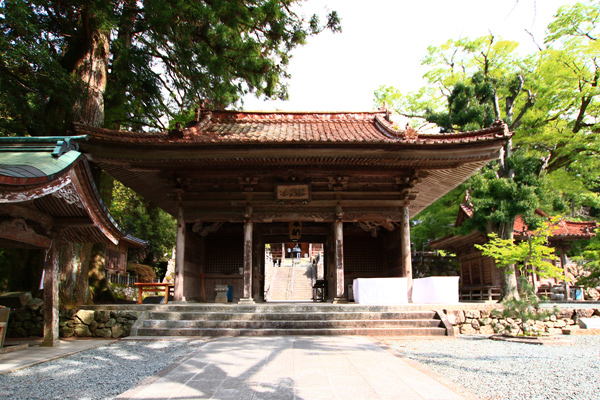The Shikoku Pilgrimage Temple Guide
Temple 43, Meisekiji

History of the temple
Meisekiji is located in Uwa Town, Seiyo City. It is a town of history and culture with places of interest such as the Museum of Ehime History and Culture, the Kaimei School (part of Uwa Bunka no Sato), the Shingido (the hiding place of Takano Choei), and many ancient tombs. Akashi Temple also has a unique history.
Since ancient times, the site of Meisekiji has been considered a holy place where Senju Kannon Bosatsu (The Thousand-armed Bodhisattva Who Hears the Sounds of the World) incarnated in the form of a girl. The origin of the temple dates back to the first half of the 6th century. An ascetic named Enshuin Shocho founded the temple by order of Emperor Kinmei (reigned 532-571) to enshrine a statue of Senju Kannon, a statue that had come from Tang China. In 734, an ascetic named Jugen brought 12 shrines from Kumano, Kishu (current Wakayama and western Mie), and built 12 monk’s cells. Meisekiji became a central place for Shugendo (a set of ascetic practices drawn from several religious traditions) and the transmission of the Buddha Dharma (Buddhist teachings).
Kobo Daishi visited the temple in 822. He saw that temple buildings were in a ruinous state and told Emperor Saga (reigned 809-823) of the situation. By the emperor's order, Kobo Daishi dedicated a copy of the Hokekyo (Lotus Sutra) on gold paper with gold ink and reconstructed the buildings. The temple fell into disrepair again during the Kamakura period (1185-1333). Minamoto no Yoritomo, a famous samurai, again had the buildings repaired. In 1194 Yoritomo dedicated a statue of Amida Nyorai (Buddha of Limitless Light and Life) to mourn the loss of Ike no Zenni (Yoritomo’s step-mother), who had saved his life. He also created a sutra mound and changed the temple’s mountain name (temples are metaphorically called mountains) to Genkōzan.
Since that time, the temple has been venerated by samurai. During the Muromachi period (1336-1573), it became a family temple of the Saionji family, and during the Edo period (1603-1868), a family temple of the Date family. The Date were the feudal lords of Uwajima, a nearby city. It had more than 70 branch temples.
Highlights
Shiawase Kannon Bosatsu
It is over two meters tall, dressed in a long, draped kimono, and holds a water jar in the left hand. It is located behind the Kyakuden.
Kobo well
On the right side just after entering the Niomon Gate. This well is said to be the site of Kobo Daishi's ascetic practices.

Details
Names: Genkōzan, Enjuin, Maeisekiji
Denomination: Tendai-Jimon Sect
Principal Image: Senju Kannon Bosatsu
Founded by: Enshuin Shocho
Founded: Early 6th century
Access
Address: 201, Ageishi, Uwa-cho, Seiyo City, Ehime 797-0007
Phone: 0894-62-0032
Parking: Cars (free of charge) Large buses/middle-sized buses (1,000 yen), microbuses (500 yen)
Lodging: None
Official website: None
